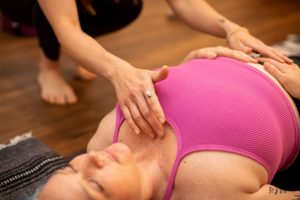Being a yoga teacher is a fulfilling career that offers and requires a lot of flexibility (referring to mental and organizational adaptability in this context!) Yoga teachers start a ripple effect of good vibes by leading a great class for people, who then go out into the world in a better mood for the people around them throughout the rest of their day.
According to the U.S. Bureau of Labor Statistics, fitness instructors (which includes yoga teachers) have a “much faster than average” projected job growth rate of 39% between 2020 and 2030.
If you’re passionate about yoga, are dedicated to exploring its intricacies, and feel the desire to impart its goodness to others, then you owe it to yourself and your community to go for it! Here’s a basic guide on the next steps:
#1 PRACTICE like a yoga teacher
As we’ve established, it is important to already have a dedicated personal yoga practice. This does not mean that you must be advanced, that every asana must form part of your practice, nor that you meditate for two hours daily, but it’s important to have a solid amount of bodily awareness and yoga experience. Perhaps you’re already great at intuiting others’ energies and creating an environment that is welcoming and safe for others—or you would like to learn how. If you have clarity of intention, you’ve reflected on signs that you’re ready to become a yoga teacher, and you’re prepared for the commitment, it’s time to take the next step!
#2 SELECT a yoga teacher training course
There are a great deal of yoga teacher training programs available worldwide that offer certification in an array of yoga styles and traditions, as well as logistics to consider (local, abroad, full time, part-time, intensive). And it’s vital to have done the research necessary to make a wise decision based on your needs and goals.
A brief history of yoga teacher training courses
In the northern region of India 5,000 years ago, yoga was usually taught from a guru to students over several years, and often in a one-on-one setting. As yoga made its way across the globe and into the 20th and 21st centuries, the demand for yoga teachers has only increased. In the 1990s, a U.S.-based membership trade and professional organization for yoga teachers, called Yoga Alliance, was established and outlined national yoga teaching standards.
You don’t have to go through YA, as it is not a requirement to teach, but if you’d like to be a Registered Yoga Teacher (RYT 200), then you must complete your training with a Registered Yoga School (RYS). Afterward, you then register with YA, and become a paying member of the organization.
Most people start their yoga teacher journey by completing a 200-hour course. There are 500-hour courses, as well, for more advanced training and specializations, but most yoga-teachers-to-be complete the 200 hours, then get some teaching experience, and later decide if they’d like to further their education by choosing a specialization (in yoga therapy, for example) for the next 300 hours.
Yoga styles and traditions
From Ashtanga to Yin, there are myriad yoga styles and traditions out there to focus on. You could even choose a more generalized course, which will expose you to multiple styles, allowing you to later decide which you’d like to pursue on a deeper level. It makes most sense to learn and teach the style you actually practice and enjoy. Oftentimes, your local studio offers exactly what you’re looking for, or can point you in the right direction.
Types of trainings, schedule, and logistics
All the different types of trainings have their pros and cons, depending on your lifestyle, when you currently have free time, and in what timeframe you’d like to complete your course.
- In-person
- Weekends
- These programs are ideal for those who’d like to fit in their training around their Monday through Friday work schedule. Though a packed weekend schedule can also be quite intense for some, these programs can also provide necessary downtime between training days so that you can fully absorb all your new knowledge.
- Weekdays
- These programs are perhaps more convenient for people who work weekends, freelancers, and stay-at-home parents. Some consist of an evening or full-day schedule, and can often be completed more quickly.
- Intensive destination retreats
- These programs are often in gorgeous locations, and are sometimes completed in as little as 2-3 weeks. They also tend to be on the pricey side, can be physically intense, and perhaps insufficient time to integrate all your new knowledge.
- Weekends
- Virtual
- Especially since Covid-19, there are now many options for online yoga teacher training courses. Online courses are convenient and flexible, allowing you to study at your own pace, at any time of day, and from anywhere in the world. A major downside though is that you miss out on the opportunity for hands-on practice and immediate feedback, which of course advances and improves your skills more quickly and effectively.
- Combination virtual and in-person
- This is the Goldilocks situation, because you have a certain amount of flexibility and time to work at your own pace, while also receiving all the benefits and on-the-ground training that an in-person program provides.
For more tips, check out our other blogs on how to choose the yoga teacher training that is right for you.
#3 COMPLETE your yoga teacher training
Simply put, you want to finish a yoga teacher training program that has a good and long-standing reputation with a thorough and interesting curriculum that you can commit to completing.
Most courses consist of yoga history, philosophy, ethics, anatomy, asana, pranayama, meditation, and sequencing. Other courses will even take you through energy management, public speaking, online how-tos, as well as administrative and organizational business skills.
From start to finish throughout the training program, you will likely read a lot, write and journal a lot, and reflect a lot on the deeper aspects of life. You will also:
- Analyze the different aspects of each asana and pranayama
- Create lifelong bonds with fellow trainees
- Fine-tune your people-reading skills
- Find and claim your voice
- Grow as a practitioner and a person
You will be stretched mentally, physically, and emotionally throughout the course, and in the most rewarding of ways.
#4 TEACH like a yoga teacher
During the training program, you will have already practiced sequencing and teaching with your fellow trainees, as well as unsuspecting (and lucky!) friends and loved ones. But once you have that certificate with your name on it, the best way to gain confidence in your abilities is to jump right in.
There are all kinds of yoga teachers out there, and none quite like you that can offer exactly what you offer. But no matter the teaching approach, all good yoga teachers possess certain qualities:
- authenticity
- preparedness
- empowering to others
- adaptable
- strong speaking skills
- consistent personal practice
Of course, you’ll want to also make sure you are clear and organized on the administrative business side of things, and you will likely want to have insurance. But then it’s time to get out there and share the yoga goodness.
Yoga teacher certification in Dayton/Centerville
Our yoga teacher training program at Ignite Yoga consists of heated power vinyasa yoga, inspired by the Baptiste Methodology, classical yoga, and modern-day thought leadership. Completing our yoga teacher training course will provide you with deep knowledge and a significantly beneficial life experience. Becoming a certified yoga teacher is actually just the start of a hopefully long and committed journey to living and embodying YOGA.
So if you hear the calling, do yourself a favor, and answer it.










One Response